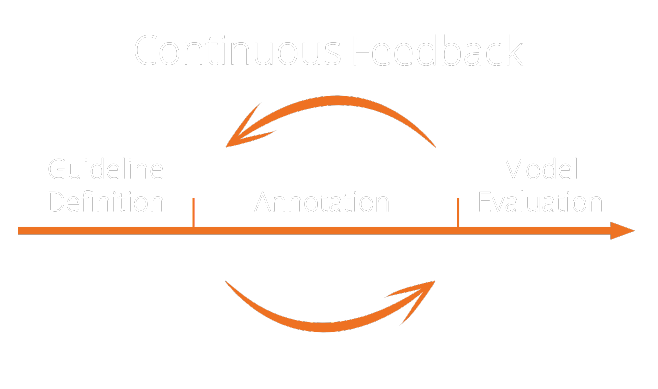ANOTACIÓN DE DATOS
ANOTACIÓN DE DATOS
La intuición humana, a escala
Al igual que un niño, una IA necesita ejemplos para aprender a interpretar la información correctamente. El juicio humano es clave para establecer los criterios correctos y tomar las decisiones correctas al anotar datos de entrenamiento. Es por eso que Sigma coloca a los humanos, facilitados por nuestro conjunto de herramientas de anotación personalizables y procesos automatizados, en el centro de nuestros proyectos de anotación.

Etiquetado de datos
Criterios definidos por expertos
Equipos de anotación seleccionados
Herramientas de etiquetado de datos
Herramientas de automatización de etiquetado de datos
La automatización de los aspectos manuales del proceso de etiquetado de datos aumenta enormemente la velocidad, la precisión y el rendimiento. Sigma utiliza un conjunto de herramientas de automatización para el procesamiento previo y posterior de datos en voz, texto, imágenes y video para ayudar a los anotadores humanos a realizar su mejor trabajo.
Etiquetado de datos asistido por aprendizaje automático
Al integrar estrechamente los modelos de aprendizaje automático con los procesos de los anotadores humanos, podemos crear ciclos de retroalimentación en los que un algoritmo utiliza datos ya anotados para predecir cómo se podría etiquetar un nuevo dato. Los anotadores reciben datos con una sugerencia precargada, lo que aumenta la coherencia y la velocidad.

En un proyecto de anotación de imágenes, utilizamos un modelo de aprendizaje automático para ayudar a predecir la forma de un objeto mediante polígonos. La cantidad de polígonos anotados por hora aumentó en 60%.

Anotaciones para texto, voz, imagen, vídeo y más
Con el respaldo de nuestro conjunto de herramientas de automatización y aprendizaje automático que cubren una amplia gama de tipos de datos y técnicas de anotación, combinamos los equipos, herramientas y procesos adecuados para brindarle datos de capacitación de la más alta calidad.
Servicios de anotación de datos.
VOZ Y TEXTO
Transcripción y diarioización
Reconocimiento de entidad
Reconocimiento de intención
Relevancia de los datos
Sentimiento y análisis emocional
Evaluación de pronunciación y dialecto.
Anotación de IA conversacional
Traducción y localización
Moderación de contenido
IMAGEN Y VÍDEO
Cuadros delimitadores 2D y 3D
Polígonos
Líneas y splines
Anotación de hito
Reconocimiento óptico de caracteres
Clasificación de imágenes
Segmentación semántica
Seguimiento de vídeo
¿No ves el tipo de anotación que necesitas? ¡Póngase en contacto, prosperamos en proyectos únicos y desafiantes!

Comentarios de calidad continuos
El control de calidad funciona mejor cuando se integra estrechamente en los flujos de trabajo de anotaciones en ejecución. A lo largo del proceso, los gerentes de proyecto revisan continuamente el trabajo de los anotadores y brindan comentarios para aclarar cualquier problema y restablecer la coherencia.

Control de calidad preventivo con soporte técnico
Nuestro enfoque de control de calidad incluye controles de calidad preventivos y automatizados que se integran directamente en la interfaz de usuario de los anotadores y se especializan en el tipo de datos que se etiquetan. Esto garantiza que los anotadores sigan cada paso del proceso, limite las inconsistencias y evite errores antes de que ocurran.
Optimización continua: herramientas y pautas
Durante los continuos ciclos de retroalimentación, nuestros gerentes de proyecto intervienen para realizar optimizaciones iterativas que mejoran la calidad de las anotaciones de inmediato, durante el proceso en ejecución. Personalizamos herramientas, pautas y procesos de forma continua para optimizar la anotación y aumentar la eficiencia.
Personalización de herramientas
Personalizamos nuestro conjunto de herramientas de anotación y etiquetado de datos de acuerdo con su flujo de trabajo único para reducir el tiempo dedicado a los pasos de anotación individuales y mejorar aún más la precisión y coherencia del etiquetado.
Refinamiento de las pautas
Nuestros gerentes de proyectos perfeccionan continuamente las definiciones de las pautas a través de ciclos de retroalimentación y creación de consenso con los anotadores, haciéndolas más precisas, claras y fáciles de seguir para los anotadores.
Contenido recomendado

¿Qué es la anotación de datos?
La anotación de datos describe la categorización y etiquetado de datos para aplicaciones de IA. Cuando los datos se atribuyen, etiquetan y etiquetan, es más fácil para los modelos de aprendizaje automático comprender de qué se tratan los datos y retener información relevante.

Incorporación de anotaciones de datos en el desarrollo de algoritmos de búsqueda
Al iterar sobre un algoritmo de búsqueda en ejecución, los ingenieros recurrieron a los equipos de anotación flexibles de Sigma para evaluar consultas y responder a los cambios sobre la marcha.

Creación de una estrategia de anotación de datos escalable
La creación de conjuntos de datos de alta calidad es esencial para el éxito de los proyectos de inteligencia artificial (IA) y aprendizaje automático (ML). Subcontratar su estrategia de anotación de datos podría ser la mejor manera de garantizar que la anotación de datos se realice correctamente y siga siendo flexible.
Trabajemos juntos para construir una IA más inteligente
Ya sea que necesite ayuda para obtener y anotar datos de capacitación a escala, o si necesita una estrategia de anotación completa para satisfacer sus necesidades de capacitación en IA, podemos ayudarlo. Póngase en contacto para obtener más información o para configurar su prueba de concepto.